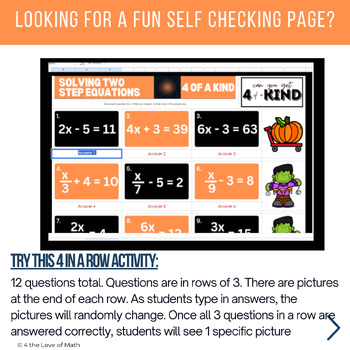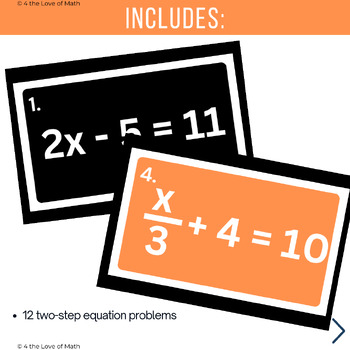Two-Step Equations Self Checking Digital Sheets Activity
- PDF
- Google Apps™

Description
Fall is in the air, and the anticipation of trick-or-treating is almost palpable. It's the perfect time to introduce students to this Halloween-themed self-checking activity on Google Sheets, designed to make mastering solving two-step equations a spooktacular adventure!
Why Use this Solving Two-Step Equation Activity:
- Immediate Feedback: Students confront 12 distinct problem cards, each adorned with orange and black colors. They receive instant feedback as they tackle two-step equations and input their answers into the sheet. Answers typed in correctly turn green, while incorrect answers remain red.
- Motivated Learning: Unlock the potential of goal-oriented learning as students strive to achieve 3 consecutive correct answers. With each correct response, a rotating array of Halloween-themed images, from spooky ghosts to creatively designed pumpkins, unfolds, revealing 1 specific picture when the row stops. It's an engaging challenge that keeps students motivated and focused.
How to Use this Solving Two-Step Equation Activity:
- Share this Google Sheets activity with your students, setting the stage for a Halloween-themed math adventure.
- Encourage them to dive into the 12 unique problem cards, aiming for the magic number: 3 consecutive correct solving two-step equation answers per row.
- Leverage the included question/answer page to offer support and guidance to students whenever they encounter challenges.
- Experience the joy of watching your students master two-step equations while enjoying a visually engaging learning experience filled with orange and black Halloween charm.
Included is a detailed question/answer page that displays every problem card alongside its solution. This makes it a breeze for you to guide your students back on track whenever they stumble.
Elevate your teaching by infusing the excitement of Halloween into math education, all while reinforcing essential math concepts. Don't miss the chance to empower your students and make learning a thrilling adventure.
Note: This activity is similar to another solving two-step equations activity. However, the other one is not Halloween-themed. The 2 activities have completely different questions & images.
If you have any questions, feel free to reach out to us at randi@4theloveofmath.com. Get started on this spook-tacular learning journey today!





